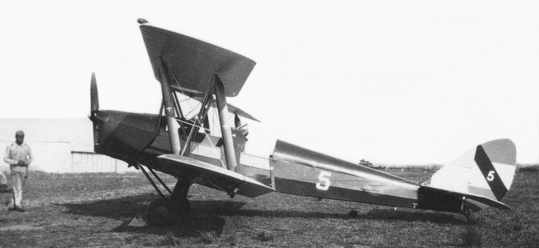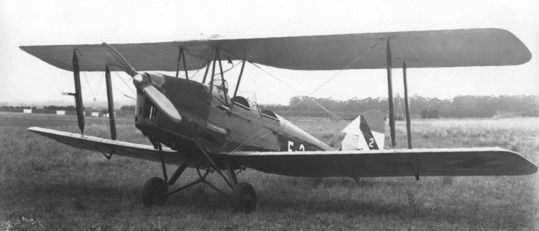|
Service
history
1935
The first aircraft were delivered on board the cargo ship Avila Star
in the middle of January 1935.
The five
aeroplanes were allocated to the Service Division of the E.M.Av,
which since 1916 had been the only aerial unit within the National
Army, and was based in the Military Aerodrome Capt. Boiso Lanza, in
the Paso de Mendoza zone of the capital city.
They were
serialled '1' to '5' and carried in sequence Constructor Numbers
(c/n) 3288, 3310, 3311, 3312 and 3313 respectively.
The fuselages
were painted green and the wings and empennage were finished in
aluminium dope. The military insignia was applied in the four
classic wing positions, whilst the Artiga”s flag occupied the whole
of the rudder.

The
post-delivery test flights were carried out personally by
Mr.Ballantyne from de Havilland. On 25th January, Nos. 2 and 3 were
tested, whilst Nos. 1, 4 and 5 flew for the first time on 28th.
On the same
day, January 28, there was an armed uprising in the north east of
the country, led by the independent nationalist leader Basilio
Muñoz. Rapidly, the Executive, under the presidency of Gabriel
Terra, took all necessary measures and the Army was mobilized
including the Potez and Tiger Moths of the Military Aviation School.
|
The
official history of the National Army says: “At the
beginning of 1935, the National Army rapidly suppressed an
armed movement against the Government formed by members of
different political factions”. Mention is made of “the
battles of Paso de Morlan and the bombing of the
revolutionary positions with Potez and Tiger Moth
aeroplanes”.
But,
as the unwriten history tells, when they dropped bombs, it
was never directly onto the revolutionaries in the hope of
avoiding bloodshed. Instead, they aimed at groups of
Basilio Muñoz´ horses in order to "disband them and leave
them walking instead of riding". |
On January 30
and 31, various reconnaissance, photography and bombing missions
were carried out by Tiger Moths 2, 3, 4, and 5, flown by Majors
Glauco Larre Borges and Oscar Gestido; Captains Joaquín Costa,
Cecilio Bentancur, Mariano Rios Gianola and Oscar Sánchez; 1st
Lieut. Raul Gomeza and the photographer Lieut.Jr. Juan C. Gambarini.
Various
detachments were posted to the operational area, with Tiger Moth 4
deployed to Tacuarembo between 4th and 11th February, carrying Major
Felipe Gutiérrez and the mechanic Brígido Albarracín. Number 3
operated in Artigas between 4th and 14th of February with Major
Glauco Larre Borges and the mechanic Juan Chabay, whilst Number 2
departed from Melo between 2nd and 10th of February with 1st Lieut.
Raul Gomeza.
Between them
these aircrafts completed around 50 missions including
reconnaissance, bombing and liaison.
When the
hostilities ceased in February 14, there were no reported losses and
all the Tiger Moths remained in flying order.

No 5 (c/n 3313) ttook
part in the actions of February ´35 against the movement led by
Basilio Muñoz.
Military
School of Aviation, Paso de Mendoza, August 1935. Photo Gualberto
Trelles, via Julio Salvo
Returned to
the Aviation School, instructor training was begun and the
preparation of courses for training new pilots. The results were
excellent, and by the end of the year the School had flown an
average of over 300 hours per aeroplane, except No 2, which had
suffered a landing accident on March 30 when it was piloted by
Sergeant Elbio Gongorra and was under repair until September 20.
On May 30,
Getulio Vargas, President of Brazil, arrived in our country for an
official visit. Three days later, the E.M.Av flew over the parade in
the President's honour with all their available machines: nine Potez
25 and four Tiger Moths, missing were only a Potez 7, lost during
the Melo campaign in February and Tiger Moth 2 under repair.
Running
parallel with the pilot courses for officers and sub officers,
during the year instruction was also given to technical staff; the
Director of Civil Aviation, Engineer Luis F. Marques, the head of
Medical Cabinet Dr. Francisco Sureda, and the School Photographer
Lieut. Jr. Juan C. Gambarini. These last two performed their first
solo flights on June 25 in Tiger Moth No 1.
To commemorate
the end of the first year with the new equipment, a formation
display was held at various locations in the Republic under orders
from the Chief of the Instruction Division and with pupils and
instructors drawn from the pilot courses.:
| Date |
Flight plan |
Duration |
|
Dec.26th |
EMAv. , Rocha , Treinta y Tres , Melo |
3 hs. 30´ |
|
Dec.27th |
Melo , Rivera , Artigas |
2 hs. 55´ |
|
Dec.28th |
Artigas , Cuaró , Salto , Paysandú ,
Colonia , EMAv. |
6 hs. 25´ |
The crews:
|
Cap. Oscar Sánchez - Tte 2º Ramón Irazábal |
|
Tte 1º Isaías Schez - Alf.
Erling Olsen Böje
|
|
May.
Felipe Gutiérrez -
Mec. Juan Chabay
|
|
Tte 1º Raúl Gomeza - Alf. Carlos M. Sención
|
|
Cbo. Hilario Almandós - Cbo. Alfonso Izarra
|
| |
On December 31, 1935, when Law No. 9538 was passed creating
'Military Aeronautics' (AM) as the fifth division of the Army,
important changes were introduced into the organization of the
aerial division. They included the creation of Aeronautical Bases
Nos.1 and 2, the Workshops Division, General Stores and Services
(later General Workshops, General Stores and Services) and the
Military School of Aeronautics (EMAer) which two years later would
be transferred to Pando Aerodrome.
At the same time identification of the aircraft was changed when a
prefix was placed in front of the serial number on the fuselage,
indicating the unit to which it belonged. In accordance with this
directive, E, B1, B2 and S were established for the EMAer, the
Aeronautical Bases and the Service Divisions respectively.
Nonetheless, photographic records show that it took a long time for
these prefixes to be painted on some of the machines..

No 2 (c/n 3310),
now with the prefix E corresponding to the EMAer. in accordance with
the directives of 31/12/35, photographed just after its repairs from
the minor accident of March 30,1935. Note the external bomb racks
behind the undercarriage and the insignia on the lower wing with the
red diagonal painted in reverse.
Photo FAU (Uruguayan Air Force) Archive 1735.
|